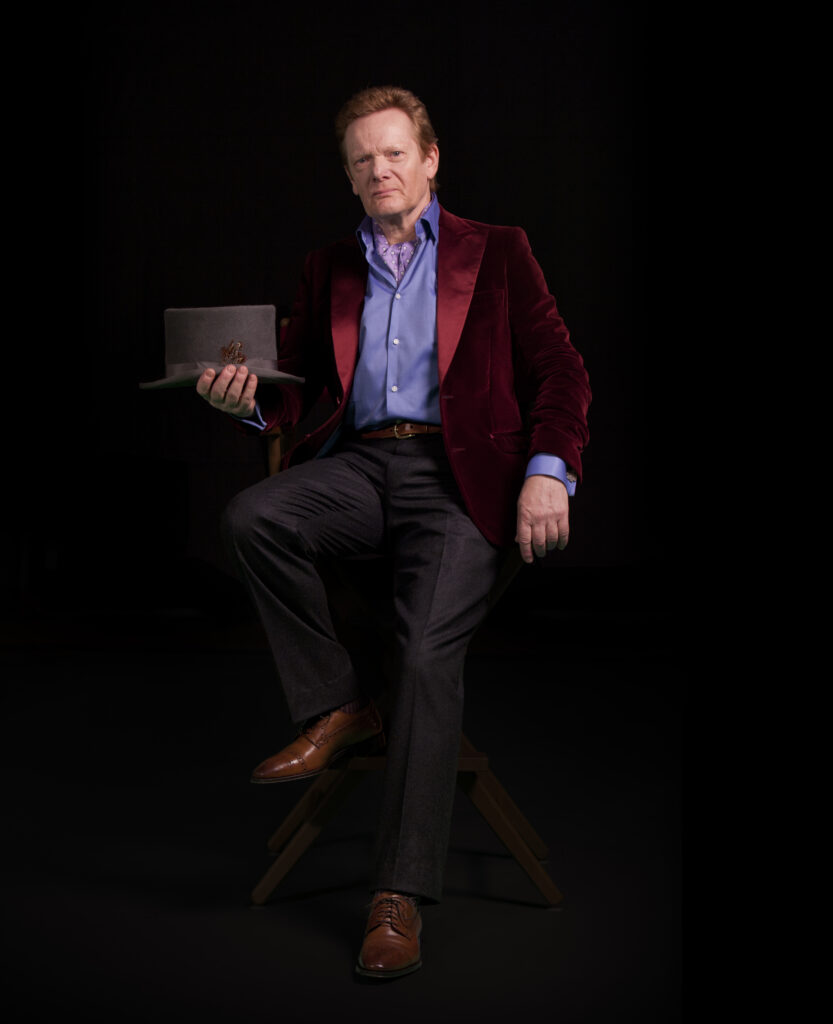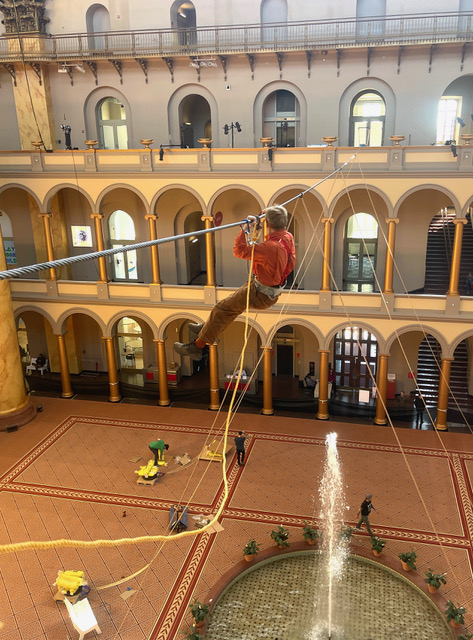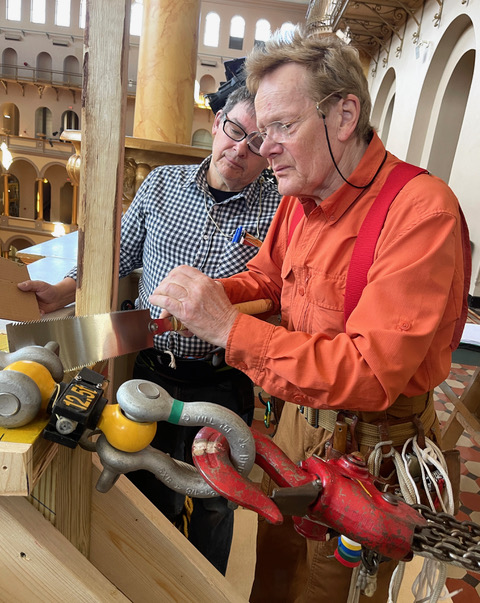The world’s most famous tight-rope walker, Philippe Petit, is much more than a daredevil thrill-seeker. TED HILDNER meets Petit at St. John the Divine, where Petit has a residency, and discovers deep emotions and true artistry behind his most brazen, seemingly mad high-wire performances.

Philippe Petit
Philippe Petit, the daring French tightrope walker has a long list of daredevil performances that brought him international stardom, starting in 1971 when he took his first (very illegal) walk between the two towers of the Cathédrale Notre-Dame. Since then, he’s tightroped for Pablo Picasso’s 90th birthday party, between the towers of the Sydney Harbor Bridge, in front of 250,000 people at the Eiffel Tower, and at countless exhibitions across the globe.
His stunts, seen by many as crazy, have won him notoriety, numerous awards, Guinness World Records titles, and a few nights behind jail bars. Petit’s story is so unusual that he has been immortalized in popular culture in hits like Robert Zemeckis’s 2009 Hollywood blockbuster The Walk, and director James Marsh’s 2008 Oscar-winning documentary, Man on Wire. Both films tell the story of Petit’s most famous walk—between New York’s World Trade Center’s Twin Towers in 1974. I was lucky enough to sit down with the living legend at the Cathedral of St. John the Divine where Petit has a long-standing residency.

Petit rigging up at the National Building Museum in Washington DC
Born in Nemours, Seine-et-Marne, France, in 1949, Petit was a teenager when he discovered the wire. “My childhood was about escaping authority, parents, school, and the world by climbing trees, climbing rocks, and using ropes. I would rappel down anything I could. Around the time I was 16, I put the rope horizontally between two trees,” he remembers. From that pivotal moment, Petit started looking at manmade structures and natural places differently. Instead of seeing a building, he saw a structure where a wire could be placed. “As a self-taught wire walker, I wanted to do beautiful things, and I didn’t copy what the circus performers were doing.”
In 1968, when Petit was only 18, he found himself in the waiting room of a Paris dentist, suffering from a tooth infection. He came across a magazine article chronicling an ambitious project in NYC to build the world’s tallest towers. “I became obsessed,” Petit says. “I was not trying to break records. I’m totally uninterested in that. I look at things more poetically, and yet there I was, fixed on the highest towers in the world that were not even built yet.” Forgetting about his aching tooth, he ran out of the office, article in hand, and organized a team of friends and experts who had both the skill sets and daredevil spirit needed to pull off such an unbelievable endeavor.
“I will never do the first step without being absolutely sure that the last step will be successful because I am not into risking my life, and I am not into frightening the people below.”
Philippe Petit
Over the next six years, Petit practiced mercilessly, and together with his team, learned and planned as much as possible. “It was like a divine prophecy in the sense that I discovered something before they were built. We worked in tandem while they were building the buildings, and we were building our approach.” A free spirit, yes, but an untethered daredevil, no. “I hate taking risks. I will never in my life take a risk. I take a risk when I cross the avenue, forgetting to look left and right for the bus because I am stupid. But in my professional life, I will never set my foot on a wire, whether a small wire across the cathedral’s nave or a 700-yard-long giant walk. I will never do the first step without being absolutely sure that the last step will be successful because I am not into risking my life, and I am not into frightening the people below.”

Petit at work
In preparation for his NYC walk three years later, Petit began performing highly visible (and illegal) walks at other monumental locations. His first walk was between Notre-Dame’s two towers in 1971. Aside from a successful performance—arrest aside—Petit’s vision and artistry were reaffirmed when, afterward, people told him that he changed the landscape of the famous cathedral forever. “The strict architectural theory is no longer the same,” Petit explains. “A piece of art has imprinted it. It is strange, but the performance uplifted people, making them believe that mountains can be moved and nothing is impossible. People’s lives were changed, and so was mine.” Two years later, he rigged a wire and walked above the Sydney Harbor Bridge. Once again he was arrested, and fined $200, but more importantly, people took notice of his artistry and formed an even greater emotional bond with his work.
This August marks the 50th anniversary of Petit’s 48-foot tightrope walk, spanning the negative space hovering 1,350 feet above the ground between the two towers of the World Trade Center. Just after 8 AM on August 7, 1974, New York witnessed the unthinkable, and possibly the greatest act of courage in a performance of any kind that the world had ever seen. Petit made eight passes between the buildings, dazzling the world with his tightrope magic. Walking, dancing, and even laying on the cable, Petit recalls hearing the roaring cheers of the crowd below while the authorities tried to get him down.
After a 45-minute performance, Petit was hauled off to jail and, upon his release, the New York District Attorney dropped all charges in return for his promise to hold a children’s performance in Central Park. During a time when the NYC economy was in crisis and the new World Trade Center was on the verge of failure, Petit accomplished his dream while also providing the city with the much-needed inspiration and pride it needed.
Since that legendary walk, Petit splits his time between Woodstock and the city. In 1979, he was appointed an artist-in-residence at the Cathedral Church of St. John the Divine on Amsterdam Avenue.. A fitting home as the cathedral’s story is as unique as Petit’s. According to the New York Times, “When Petit arrived at St. John the Divine, the church, like the city itself, had more problems than promises. New York City was amid a financial crisis that almost drove it to bankruptcy. The cathedral, sitting between Columbia University and Morningside Park, symbolized the city’s stagnancy. The building was unfinished even a century after its cornerstone had been laid. What had been built was largely unused, and it sat on a neglected piece of property.”
In 1972, the Reverend James Morton took over as the dean of St. John the Divine and, according to Petit, “created a culture, an artistic culture and turned it into this center for humanitarian rights and the arts by helping the homeless and educating people.” Morton wanted to engage the city in all its problems and help inspire those who needed help. Ahead of his time, Morton welcomed gay clergy and leaders of other faiths. He invited inspirational guests like Nobel prizewinners Elie Wiesel and the Dalai Lama as guest speakers. And he invited Petit to become a permanent part of the community, set up his professional home, and continue inspiring people through his art. “Upon introducing me to the congregation, Reverend Morton made a speech, saying, ‘Philippe doesn’t believe in God, but God believes in Philippe.’”
“In 45 years, I have given 23 performances to help raise awareness of the church’s missions and the funds needed to continue the unfinished building of the church. I did a big walk that was on the front page of the New York Times with a picture that showed me high above Amsterdam Avenue,” he says. Taking me outside and pointing up toward the sky, he showed me how there should be two towers, but they were never finished. “We now have one tower, 10 stories high, and some people say it’s because of me that they found the money.” Petit is proud to point out that this is his home, an amazing, inspirational place that he has been fortunate to have had all these years. “My relationship with the church is built upon an unwritten moral exchange, and occasionally, I help by creating performances,” he adds.
“Upon introducing me to the congregation, Reverend Morton made a speech, saying, ‘Philippe doesn’t believe in God, but God believes in Philippe.’”
Philippe Petit
On August 7, Petit will be hosting a performance honoring the 50th anniversary of his legendary high-wire walk between the Twin Towers. The show will take place at none other than St. John the Divine and feature a special performance by Petit’s longtime friend Sting, who will perform original music written for the event.
At 74, Petit, a true artist, has no plan on settling down. “Why would I retire? I think it’s a very safe profession if you have a love of life, and I love my life,” he declares. So, instead of slowing down, he practices on a wire for three hours a day and continues spreading inspiration through his art. Petit says the most common question he gets is, “Why did you do that?,” and the answer is always the same: “There is no ‘why’ in my life. It’s because I have no choice, which I think is a very beautiful answer.”
Like the twin towers, the cathedral, or the city itself, Phillipe Petit is truly a New York story. Although much of his artistry lives in the empty spaces of the sky, his likeness and spirit will live forever. Intricately etched into the stone surrounds of the grand doors leading into the world’s largest Gothic cathedral is the image of a mortal man, replete with wire and balance poles, and an independent, unique spirit for all the world to see.

